Embark on a culinary journey to the heart of Italy with this exquisite slow-roasted porchetta recipe, a magnificent center-piece perfect for any holiday feast or special occasion. This comprehensive guide will demystify the process, ensuring you achieve a succulent, herb-infused pork roast with that highly coveted, irresistibly crispy skin. From selecting the finest cuts of meat to mastering the reverse-sear roasting technique, we’ll cover every step, making this Italian classic an accessible triumph in your kitchen. Get ready to impress your guests with a dish that combines rustic charm with sophisticated flavors and textures.
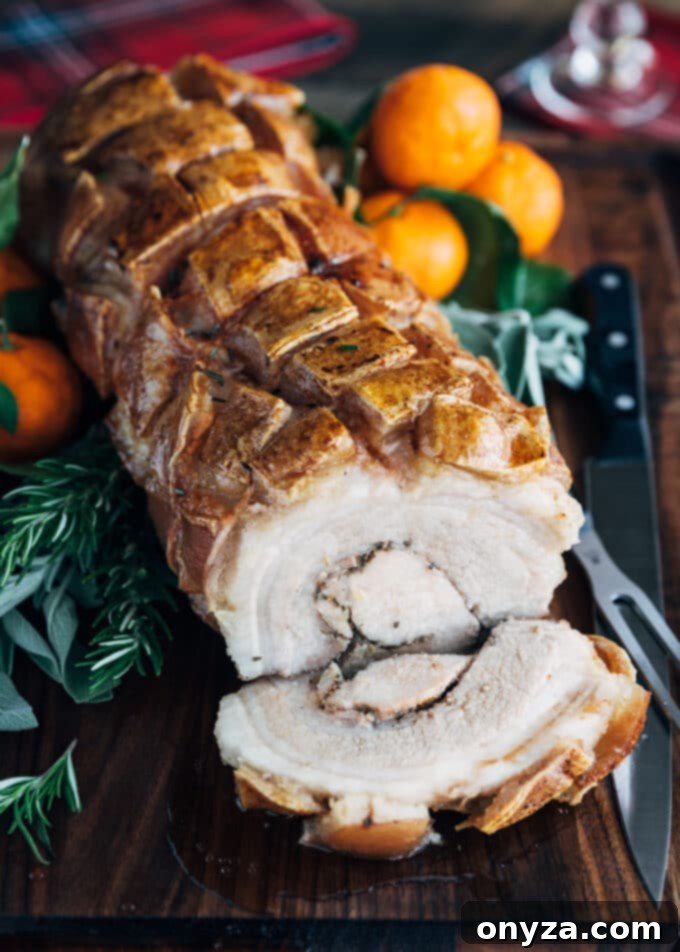
What is Porchetta? The Heart of Italian Roast Pork
Porchetta is a celebrated Italian roasted pork dish, deeply rooted in the culinary traditions of Central Italy, particularly around Rome and the Lazio region. Traditionally, in its purest form, porchetta is crafted from a whole boneless suckling pig. This pig is meticulously deboned, then generously stuffed with an aromatic medley of wild fennel, garlic, fragrant herbs, and often rich additions like pork liver, ground pork, or seasoned sausage. Once prepared, it is typically rolled, tied, and slow-roasted over a spit for several hours until the meat is incredibly tender and the skin transforms into a golden, brittle crackling.
While the whole suckling pig preparation remains a hallmark in Italy, the porchetta recipe we often encounter in America is a more practical adaptation. Here, chefs and home cooks recreate the essence of this traditional dish by crafting a substantial pork roast. The most popular rendition involves a succulent pork loin, generously seasoned and stuffed, then expertly wrapped in a fatty slab of skin-on pork belly. This ingenious construction allows for the signature tender interior and crispy exterior, mimicking the complex flavors and textures of its traditional counterpart without requiring an entire pig.
Regional variations abound even within Italy. For instance, the town of Ariccia is renowned for its specific style of porchetta, often spiced with black pepper, garlic, and rosemary, and celebrated in an annual festival. These subtle differences highlight the dish’s rich cultural tapestry, each region adding its unique touch while maintaining the core principles of a flavorful, slow-roasted pork.
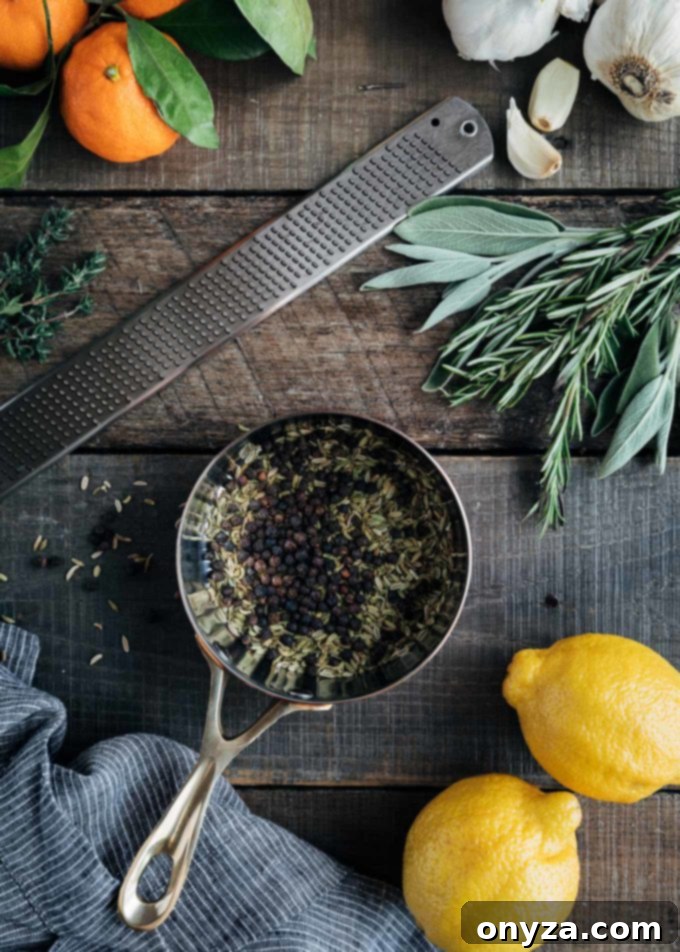
Crafting the Perfect Porchetta: An Aromatic Herb and Spice Stuffing
The soul of any exceptional porchetta lies in its stuffing – a deeply flavorful rub that permeates the pork, infusing it with an unforgettable aroma and taste. For this modern porchetta recipe, we create an intensely aromatic blend of carefully selected spices, fresh herbs, and pungent garlic. Fennel seeds and black peppercorns are non-negotiable, forming the traditional backbone of the flavor profile. The addition of bright citrus zest introduces a layer of freshness that beautifully complements the richness of the pork.
To truly unlock the full potential of their flavors, I always recommend toasting the fennel seeds and black peppercorns. A brief session in a dry skillet over medium heat, until fragrant and lightly golden, will awaken their essential oils, deepening their complexity. Once cooled, these toasted spices are ground in a spice grinder, releasing their potent aromas. This freshly ground mixture is then combined with finely chopped fresh rosemary, sage, and thyme leaves – a classic trio that brings earthy, piney, and slightly peppery notes. Plenty of fresh chopped garlic provides a foundational pungency, while orange and lemon zests brighten the entire blend, cutting through the richness with their vibrant acidity and fragrance.
For those who appreciate a subtle kick, a touch of crushed red pepper flakes can be incorporated, adding a hint of warmth without overwhelming the delicate balance of herbs and spices. However, if you prefer a milder roast, these can be easily omitted. Unlike some traditional porchetta recipes that might include additional meats in the stuffing, this version focuses purely on the herb and spice mixture. This allows the inherent richness of the pork to shine through, creating a cleaner, more intense flavor experience that perfectly balances the tender meat with the vibrant seasoning.
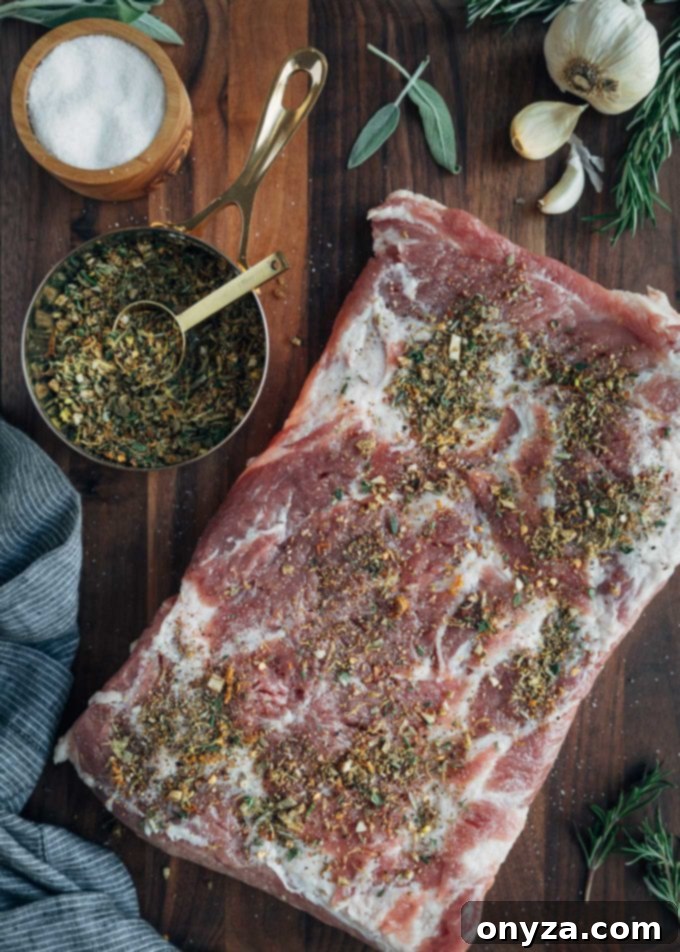
Sourcing Quality Cuts: Buying Meats for Your Porchetta Roast
The success of your homemade porchetta hinges significantly on the quality and type of pork you select. For this recipe, you will need two primary cuts: a center-cut pork loin and a large piece of skin-on pork belly.
First, procure a **3-4 pound center-cut pork loin**. It is crucial to specify “pork loin” and not “pork tenderloin” when speaking to your butcher. While both are lean cuts, pork tenderloin is much smaller, cooks very quickly at high temperatures, and is ill-suited for the slow roasting required by porchetta. Pork loin, on the other hand, is larger, has a more robust texture, and holds up beautifully to extended cooking, becoming incredibly tender and juicy.
The pork loin will need some preparation before stuffing and rolling. It must be trimmed of excess silver skin and “double-butterflied.” This technique involves making two deep cuts along the length of the loin, without cutting all the way through, allowing it to open up like a book and then further flatten into a large, even slab. This expansive surface is essential for spreading the herb stuffing evenly and then rolling it tightly. While experienced home cooks can certainly tackle this with a sharp knife, I highly recommend asking your butcher to butterfly the pork loin for you. They have the expertise and the right tools to do it quickly and efficiently, ensuring an even thickness that is crucial for uniform cooking.
Secondly, you will require a **5-6 pound piece of skin-on pork belly**. This cut is paramount for achieving the characteristic crispy crackling and the overall rich flavor profile of porchetta. Pork belly often needs to be specially ordered from your butcher, as it might not be a standard item readily available in all display cases. Many butcher counters tend to cut pork belly into smaller, more manageable portions for general sale. For porchetta, you need a substantial, rectangular piece that is large enough to completely encase the rolled pork loin. It’s always best to communicate your intentions to your butcher. Tell them you are making porchetta and ask them to confirm that the selected piece of pork belly will adequately wrap around your butterflied and rolled pork loin. This small step can save you the frustration of additional trimming and adjustments once you return home. A good butcher can be an invaluable asset in preparing this show-stopping roast.
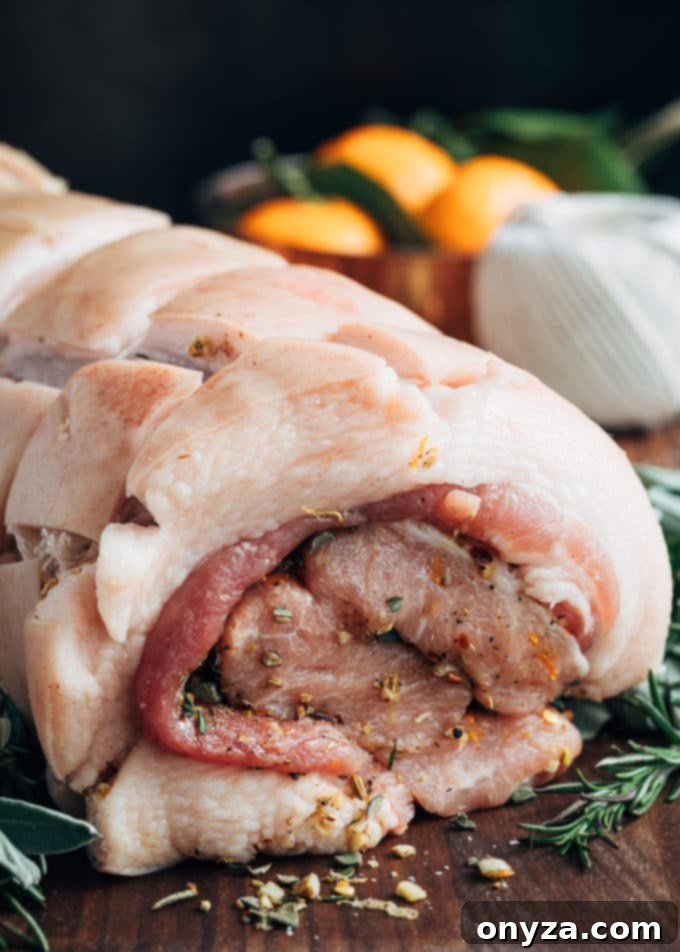
Mastering the Art of Porchetta: Slow Roasting for Ultimate Crackling and Tenderness
Creating a truly remarkable porchetta is a labor of love, requiring a multi-day process that, while not demanding constant attention, certainly benefits from careful planning. It’s advisable to begin prepping your porchetta one to two days before you intend to roast it. This extended preparation period is key to developing profound flavors and achieving that signature, shatteringly crispy pork skin.
Preparing the Pork Roast for the Oven: Assembly and Initial Seasoning
The journey to perfect porchetta begins with preparing the pork belly. Using the tip of a sharp paring knife, pierce small holes all over the meat-side (the non-skin side) of the pork belly. Don’t be timid with this step; these punctures serve a dual purpose. They effectively tenderize the rich pork belly, allowing it to become incredibly succulent during the long roast. More importantly, these small openings create channels for the potent spice rub to penetrate deeply into the meat, ensuring every bite is bursting with flavor. After perforating, generously sprinkle the pork belly with kosher salt, then rub in half of your aromatic spice mixture, working it well into all the crevices.
Next, turn your attention to the butterflied pork loin. Season it equally with kosher salt and the remaining half of the spice mixture. Unlike the pork belly, there’s no need to poke holes in the loin, as its leaner texture readily absorbs the seasoning. Once seasoned, tightly roll the pork loin from one of its long ends into a compact cylinder. This creates the inner core of your porchetta. Now, carefully wrap the seasoned pork belly around the rolled pork loin, ensuring the skin side is facing outwards. It’s crucial that this outer layer is snug and even.
To maintain its perfect cylindrical shape and prevent it from unrolling during cooking, securely tie the assembled porchetta with butcher’s twine at approximately 1-inch intervals. This tight binding is essential for uniform roasting and for achieving a visually appealing, compact final product.

The Secret to Success: Achieving Irresistible Cracklings
One of the most defining and anticipated characteristics of a porchetta roast is its crispy pork skin, famously known as crackling. Achieving this golden, crunchy perfection requires a few crucial steps that focus on moisture removal and proper preparation.
- To Score or Not to Score the Skin: Before moving to the next steps, decide whether you wish to score the skin of your pork belly. Scoring involves making shallow, crosshatch patterns across the skin. This technique not only creates a visually stunning presentation with intricate crispy-edged crackling pieces but also helps the fat render more efficiently, contributing to overall crispiness. If you opt to score, use an extremely sharp knife or a razor blade to cut a crosshatch pattern in 1- to 2-inch widths, taking great care not to slice too deeply into the pork belly meat itself. Your butcher can also perform this task for you, often with greater precision. It’s important to note that scoring is entirely optional. An unscored porchetta will still develop incredibly crispy skin and will have a smoother, more rustic appearance when roasted. The decision is purely based on your aesthetic preference.
- The Magical Rub: Salt and Baking Soda: After the porchetta is expertly rolled and tied, and you’ve decided on scoring (or not), the next vital step is to rub the pork belly skin with a mixture of salt and baking soda. This powerful combination works wonders by drawing out excess moisture from the skin. Salt is a well-known dehydrating agent, while baking soda alters the pH on the skin’s surface, enhancing browning and crispness. This critical rub sets the stage for the skin to transform into that coveted crispy perfection during roasting.
- The Uncovered Rest: A Key to Crispy Skin and Flavor Development: For the ultimate crispy skin and the most intensely flavored meat, place your prepared porchetta roast on a rack set within a baking pan. This rack allows for air circulation around the entire roast. Then, refrigerate the porchetta, completely uncovered, for a period of 1 to 2 days. This extended, uncovered resting period is perhaps the most crucial step for superior crackling. It allows the air in the refrigerator to further dry out the pork skin, reducing its moisture content dramatically. Simultaneously, this rest gives the dry rub ample time to deeply penetrate the meat, tenderizing it and infusing it with layers of flavor. Do not skip this step!
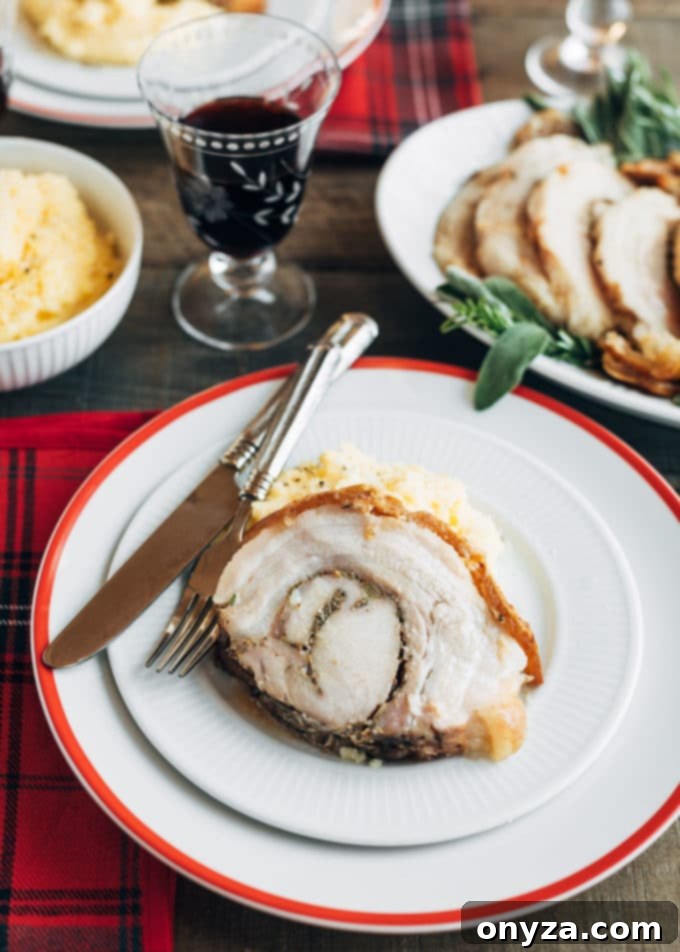
The Main Event: Roasting Porchetta to Perfection with a Reverse-Sear
The roasting method for porchetta is designed to yield an exceptionally tender and juicy interior coupled with a spectacular, crunchy exterior. Much like preparing a prime rib, I advocate for a **reverse-sear method** for this porchetta recipe. This technique involves a low-temperature roast followed by a high-temperature blast, guaranteeing optimal results.
Begin by preheating your oven to a relatively low temperature, specifically 275 degrees F (135 degrees C). Place the porchetta in the preheated oven and roast it slowly until the internal temperature of the pork loin reaches 140 degrees F (60 degrees C). For the 3-4 pound pork loin and 5-6 pound pork belly specified in this recipe, this initial slow roasting phase will typically take approximately 3 to 3-1/2 hours. Using a reliable meat thermometer inserted into the thickest part of the pork loin (avoiding bone or fat) is essential for accuracy.
Once the porchetta reaches its target internal temperature, carefully remove it from the oven. Tent it loosely with aluminum foil to keep it warm and allow the juices to redistribute while you prepare for the next stage. Immediately increase your oven temperature to a searing hot 500 degrees F (260 degrees C). This high heat is what will create that coveted, deeply golden and crispy crackling.
Once the oven is fully preheated, remove the foil and return the porchetta to the scorching hot oven. Continue roasting for an additional 15-20 minutes. During this final phase, keep a close eye on the porchetta, as the skin can go from perfectly crisp to burnt very quickly at such high temperatures. The goal is to achieve a deep golden brown color and a skin that is audibly crisp when tapped. This reverse-sear technique is a game-changer, ensuring an ultra-tender, incredibly juicy pork loin at the center, surrounded by the most gloriously crispy skin imaginable.

Serving Your Porchetta: Accompaniments and Wine Pairings
Carving and serving porchetta is part of the experience. To begin, I find it helpful to use a serrated knife to initially cut through the resilient, crispy pork skin. Once you’ve breached the crackling, you might switch to a smooth meat carving knife for cleaner, smoother slices of the tender pork, especially if presentation is a priority. However, for home dining, a serrated knife can handle the entire task perfectly well.
It’s quite common for the pork skin (crackling) to detach from the belly during carving. Don’t worry, this is perfectly normal and even desirable! I often like to cut these delicious cracklings into smaller, bite-sized pieces, particularly if the skin wasn’t scored before roasting. Serve these alongside the sliced porchetta, as they provide an incredible textural contrast and burst of flavor.
Given the porchetta’s inherent richness and complex herb-infused flavors, it truly shines when served simply. A creamy scoop of polenta, with its subtle corn flavor and velvety texture, makes an ideal accompaniment, soaking up all the delicious pork juices. Alternatively, a classic serving of fluffy mashed potatoes provides a comforting and familiar counterpoint. This is not a roast that typically requires a heavy gravy; its natural juices are flavorful enough. However, if you desire to introduce a bright, fresh element, a drizzle of vibrant Italian Salsa Verde can be a wonderful touch, offering a piquant herbaceous contrast to the rich pork.
And don’t forget the joyous prospect of leftovers! A porchetta sandwich, piled high with thinly sliced pork and crispy crackling, perhaps with a dollop of aioli or some pickled vegetables, is an absolute culinary treat and one of my favorite post-holiday lunches. The flavors deepen overnight, making the sandwich truly exceptional.

To elevate your porchetta experience, consider pairing it with a thoughtfully chosen wine. Certified Sommelier, Hugh Preece, offers these excellent suggestions:
Suggested Pairing: Falesco ‘RC2’ Sagrantino di Montefalco DOCG
This Italian red wine from Umbria presents a penetrating ruby red color with bright highlights. It offers enticing aromas of red fruit, ranging from blackberry to ripe plum. On the palate, it is remarkably well-balanced, exhibiting a factual elegance that stands up beautifully to the richness of porchetta, complementing its savory notes without overpowering them.
Daring Pairing: De Vescovi Ulzbach ‘Vigilius’ Teroldego Rotaliano DOC
For those seeking a bolder complement, this robust wine from Trentino-Alto Adige is an excellent choice. It boasts a healthy spiced palate, showcasing complex flavors of mulberry, black currant, wild herbs, and a distinctive earthy minerality, with subtle violet undertones. Its powerful structure and savory notes will create an intriguing and memorable counterpoint to the porchetta.

Porchetta Recipe
by Amanda Biddle
This rich Italian pork roast makes an impressive presentation for a holiday dinner. Porchetta cooking times do not include the 24-48 hour rest prior to roasting.
Prep Time: 30 minutes
Cook Time: 3 hours 30 minutes
Total Time: 4 hours
Servings: 8 to 12 servings
Ingredients
Porchetta
- 5-6 pound pork belly, skin on*
- 3-4 pound center-cut pork loin, trimmed and butterflied
- 2 tablespoons kosher salt
- 1 teaspoon baking soda
Spice Rub
- 2 tablespoons fennel seeds
- 1 tablespoon black peppercorns
- 1 tablespoon chopped fresh sage
- 1 tablespoon chopped fresh rosemary
- 1 tablespoon chopped fresh thyme
- 1 teaspoon grated orange zest
- 1 tablespoon grated lemon zest
- 5 cloves garlic, finely chopped
- 1 teaspoon crushed red pepper flakes (optional)
Instructions
Make the Spice Rub
- Combine fennel seeds and peppercorns in a small skillet. Toast over medium heat, stirring often, until lightly golden and fragrant, about 3-5 minutes. Cool and transfer to a spice grinder. Pulse until finely ground. (Alternatively, you can use a mortar and pestle.)
- In a small bowl, combine the ground spices with sage, rosemary, thyme, lemon zest, orange zest, garlic, and red pepper flakes.
Assemble the Porchetta
- Use the tip of a paring knife to make small holes all over the meat side of the pork belly. Season with about 1-1/2 teaspoons kosher salt and half of the spice mixture, rubbing it into the meat.
- Season the pork loin with 1-1/2 teaspoons of kosher salt and the remaining half of the spice mixture. Tightly roll the pork loin from the long end into a cylinder.
- Roll the pork belly (skin side out) around the rolled pork loin. Tie the loin with butcher’s twine at 1-inch intervals.
- In a small bowl, combine 1 tablespoon kosher salt and 1 teaspoon baking soda. Rub the salt and baking soda mixture all over the skin.
- Place the porchetta on a rack set in a roasting pan or rimmed baking sheet. Refrigerate, uncovered, 24-48 hours.
Roast the Porchetta
- Take the porchetta out of the refrigerator 2 hours before roasting and allow to rest at room temperature. Preheat oven to 275 degrees F.
- Roast the porchetta for 3 to 3-1/2 hours, until the internal temperature of the pork loin is 140 degrees F. Remove from oven, tent with foil, and increase oven temperature to 500 degrees F.
- Uncover the porchetta and return it to the oven to roast until the skin is deep golden and crispy, about 15-20 minutes longer. Watch it closely so it doesn’t burn.
- Place the porchetta on a carving board, snip and remove the twine, and let rest 10 minutes before slicing. It can be helpful to use a serrated knife to cut through the pork skin. If desired, cut the skin (crackling) into small pieces to serve alongside the sliced pork. Serve hot.
Notes
*If desired, you can score the pork belly skin in a crosshatch pattern, with cuts 1-2 inches apart. Use a very sharp knife and be careful not to cut down into the meat. You can also ask your butcher to do this.
For detailed tips and shopping info for this recipe, be sure to read through the blog post.
Nutrition Estimate
- Calories: 1365 kcal
- Carbohydrates: 2 g
- Protein: 52 g
- Fat: 126 g
- Saturated Fat: 45 g
- Cholesterol: 249 mg
- Sodium: 1648 mg
- Potassium: 976 mg
- Fiber: 1 g
- Vitamin A: 125 IU
- Vitamin C: 3.7 mg
- Calcium: 45 mg
- Iron: 2.5 mg
Nutrition information is automatically calculated, so should only be used as an approximation.
About our recipes
Please note that our recipes have been developed using the US Customary measurement system and have not been tested for high altitude/elevation cooking and baking.
